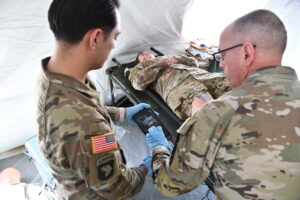
Story by Jose Rodriguez
U.S. Army Medical Center of Excellence
JOINT BASE SAN ANTONIO, TX – Recently the U.S. Army Medical Evaluation Test Activity conducted an operational test of three ultrasound field portable devices. The test was conducted for the U.S. Army Medical Materiel Development Activity (USAMMDA)/Warfighter Expeditionary Medicine and Treatment (WEMT) Project Management Office to evaluate how the devices perform in a simulated operational environment. Currently the U.S. Army does not have portable ultrasound devices for deployed medicine. One of the three devices being tested will be selected by USAMMDA/WEMT to provide Soldiers with a new capability for battlefield medicine.
The ultrasound field portable is a small, lightweight, portable, U.S. Food and Drug Administration cleared ultrasound device. It is a new requirement to fill a capability gap for the Tactical Combat Medical Care, Austere Tactical Care, and Special Forces Tactical Medical Equipment Sets. The ultrasound device directs high-frequency sound waves at the internal body structures being examined. The reflected sounds, or echoes, are recorded to create an image that can be seen on a portable viewing screen. The sound waves are emitted and received from a small, hand-held probe and/or probes.
Army 65D Physician Assistant Maj. Maya Lowell with USAMTEAC described the benefit of the operational test. “The ultrasound is intended to go down to a Role 1/battalion aid station (BAS) and Role 2, so it’s important that we assess how the device performs in different environmental conditions. At the Role 1 where there currently is no imaging capability, the ultrasound may be able to identify several pathological processes such as internal bleeding. It’s a tool that someone at the Role 1 can use to determine how critical that patient is, what medical interventions they are going to need, and what evacuation category they should be.”
The operational test was run by Eddie Fields, USAMTEAC Test Officer, who planned three different scenarios for the test. Three different ultrasound field portable devices from separate manufacturers were tested. During the operational test, all test players went through the lanes to test the three devices. This allowed the USAMTEAC test team to observe how the separate devices performed under different field conditions, different lighting conditions, and by different types of Army medical providers. Fields stated, “The active engagement of the test players in the scenarios added realism to this operational test. Their valuable feedback will be used in the final test report.”
The first lane consisted of “tailgate medicine” in an Army field litter ambulance where the device was used to determine the type of injury sustained by a simulated casualty near point of injury. Special Operations Forces Medics received a casualty, performed a trauma assessment utilizing an ultrasound, and transferred the casualty to the Role 1. At the Role 1, Army physicians and physician assistants performed an assessment with the ultrasound and then transferred the casualty to the Role 2. At the Role 2 a physician, medic, and physical therapist performed an exam using the portable ultrasound.
The USAMTEAC test team will write a detailed test report about this operational test for USAMMDA/WEMT PMO. This operational test data will assist the USAMMDA/WEMT PMO on selecting one vendor for contract award and Army-wide fielding. The goal is to have a portable ultrasound in the field by fiscal year 2026.
USAMTEAC directly supports the U.S. Army’s acquisition process by providing objective reports on medical equipment used by Soldiers. Sgt. 1st Class James Wilcox, a USAMTEAC test officer said, “When contractors and vendors make a product, they can make the best product in the world that does everything we need it to do, but sometimes it can’t be utilized effectively, for various reasons, in the operational environment. It’s important for USAMTEAC to conduct these tests because we provide feedback to the Army on whether it is effective, suitable, and sustainable”.
For Wilcox, working at USAMTEAC has given him a unique perspective on the process of fielding medical devices. “It makes me feel good to see the fruits of our labor,” he said. “We’ve all had a piece of equipment that we’ve always wondered ‘How did this get fielded?’ Now working for USAMTEAC I can shape how operational tests are conducted, and I know a couple years from now when I have Soldiers as a First Sergeant, I can say ‘Hey I tested that particular medical equipment or device and that it went through the proper testing process.’ I understand the effectiveness of that device because I helped test that capability.”
Aligned under the U.S. Army Medical Center of Excellence, USAMTEAC’s mission is a unique one in that it is the sole independent operational test and evaluation agency for medical related materiel and medical information management/information technology products. USAMTEAC is charged with the mission of directly supporting the U.S. Army in the Department of Defense’s acquisition process. Residing on Joint Base San Antonio, Fort Sam Houston, TX, the base that serves as the Army’s bastion of medical excellence, USAMTEAC is a small unit of approximately two dozen military and civilian personnel tasked with the mission of helping to ensure that medical personnel are equipped with suitable and effective equipment.